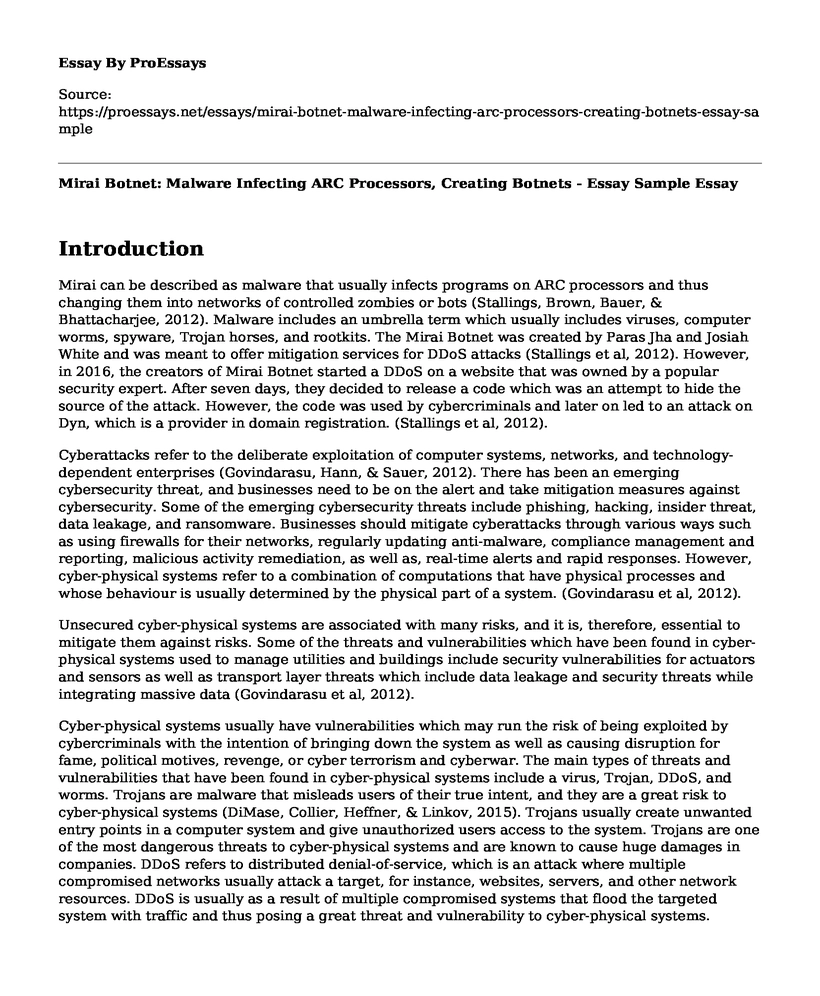Introduction
Mirai can be described as malware that usually infects programs on ARC processors and thus changing them into networks of controlled zombies or bots (Stallings, Brown, Bauer, & Bhattacharjee, 2012). Malware includes an umbrella term which usually includes viruses, computer worms, spyware, Trojan horses, and rootkits. The Mirai Botnet was created by Paras Jha and Josiah White and was meant to offer mitigation services for DDoS attacks (Stallings et al, 2012). However, in 2016, the creators of Mirai Botnet started a DDoS on a website that was owned by a popular security expert. After seven days, they decided to release a code which was an attempt to hide the source of the attack. However, the code was used by cybercriminals and later on led to an attack on Dyn, which is a provider in domain registration. (Stallings et al, 2012).
Cyberattacks refer to the deliberate exploitation of computer systems, networks, and technology-dependent enterprises (Govindarasu, Hann, & Sauer, 2012). There has been an emerging cybersecurity threat, and businesses need to be on the alert and take mitigation measures against cybersecurity. Some of the emerging cybersecurity threats include phishing, hacking, insider threat, data leakage, and ransomware. Businesses should mitigate cyberattacks through various ways such as using firewalls for their networks, regularly updating anti-malware, compliance management and reporting, malicious activity remediation, as well as, real-time alerts and rapid responses. However, cyber-physical systems refer to a combination of computations that have physical processes and whose behaviour is usually determined by the physical part of a system. (Govindarasu et al, 2012).
Unsecured cyber-physical systems are associated with many risks, and it is, therefore, essential to mitigate them against risks. Some of the threats and vulnerabilities which have been found in cyber-physical systems used to manage utilities and buildings include security vulnerabilities for actuators and sensors as well as transport layer threats which include data leakage and security threats while integrating massive data (Govindarasu et al, 2012).
Cyber-physical systems usually have vulnerabilities which may run the risk of being exploited by cybercriminals with the intention of bringing down the system as well as causing disruption for fame, political motives, revenge, or cyber terrorism and cyberwar. The main types of threats and vulnerabilities that have been found in cyber-physical systems include a virus, Trojan, DDoS, and worms. Trojans are malware that misleads users of their true intent, and they are a great risk to cyber-physical systems (DiMase, Collier, Heffner, & Linkov, 2015). Trojans usually create unwanted entry points in a computer system and give unauthorized users access to the system. Trojans are one of the most dangerous threats to cyber-physical systems and are known to cause huge damages in companies. DDoS refers to distributed denial-of-service, which is an attack where multiple compromised networks usually attack a target, for instance, websites, servers, and other network resources. DDoS is usually as a result of multiple compromised systems that flood the targeted system with traffic and thus posing a great threat and vulnerability to cyber-physical systems.
Computer worms are another type of threats and vulnerability to cyber-physical systems since they usually replicate themselves in order to spread to other computers, bandwidth as well as overloading web servers. Computer viruses such as resident virus, direct action, browser hijacker, and boot sector virus pose threats to cyber-physical systems, and when executed, they usually replicate by modifying other computer programs and insert their own codes. Therefore, institutions and companies should develop ways of mitigating threats and vulnerabilities to cyber-physical systems through measures such as installing firewalls and anti-malware.
References
DiMase, D., Collier, Z. A., Heffner, K., & Linkov, I. (2015). Systems engineering framework for cyber-physical security and resilience. Environment Systems and Decisions, 35(2), 291-300. Retrieved from https://scholar.google.com/scholar?hl=en&as_sdt=0%2C5&q=cyber-physical+threats+and+vulnerabilities&btnG=
Govindarasu, M., Hann, A., & Sauer, P. (2012). Cyber-physical systems security for the smart grid. Future Grid Initiative White Paper, PSERC, Feb. Retrieved from https://scholar.google.com/scholar?hl=en&as_sdt=0%2C5&q=Cyberattacks+on+cyber-physical+systems&btnG=#d=gs_cit&u=%2Fscholar%3Fq%3Dinfo%3AFCyi5I-ZBkAJ%3Ascholar.google.com%2F%26output%3Dcite%26scirp%3D2%26hl%3Den
Stallings, W., Brown, L., Bauer, M. D., & Bhattacharjee, A. K. (2012). Computer security: principles and practice (pp. 978-0). Upper Saddle River (NJ: Pearson Education. Retrieved from https://scholar.google.com/scholar?hl=en&as_sdt=0%2C5&q=computer+security+threats&btnG=#d=gs_cit&u=%2Fscholar%3Fq%3Dinfo%3Af6xZqSl9rTUJ%3Ascholar.google.com%2F%26output%3Dcite%26scirp%3D1%26hl%3Den
Cite this page
Mirai Botnet: Malware Infecting ARC Processors, Creating Botnets - Essay Sample. (2023, Feb 15). Retrieved from https://proessays.net/essays/mirai-botnet-malware-infecting-arc-processors-creating-botnets-essay-sample
If you are the original author of this essay and no longer wish to have it published on the ProEssays website, please click below to request its removal:
- Comparison Essay Example: Winn and Gibson
- Essay Sample on General Data Protection Regulation (GDPR) and California Consumer Privacy Act of 2018
- Health Informatics and Surveillance Paper Example
- Internet Revolution: Transforming Lives & Business Activities - Essay Sample
- Essay Example on Big Data: Unlocking Hidden Insights for Better Results
- Essay Example on AI & IoT: Enhancing the Internet Experience
- Research Paper Sample on The Year 2000: A Significant Period of Global Change and Technological Advancements







